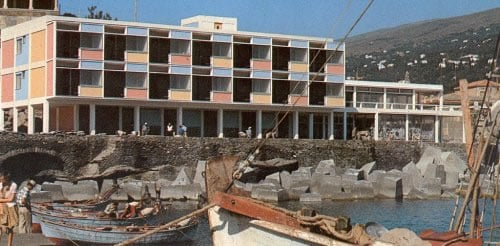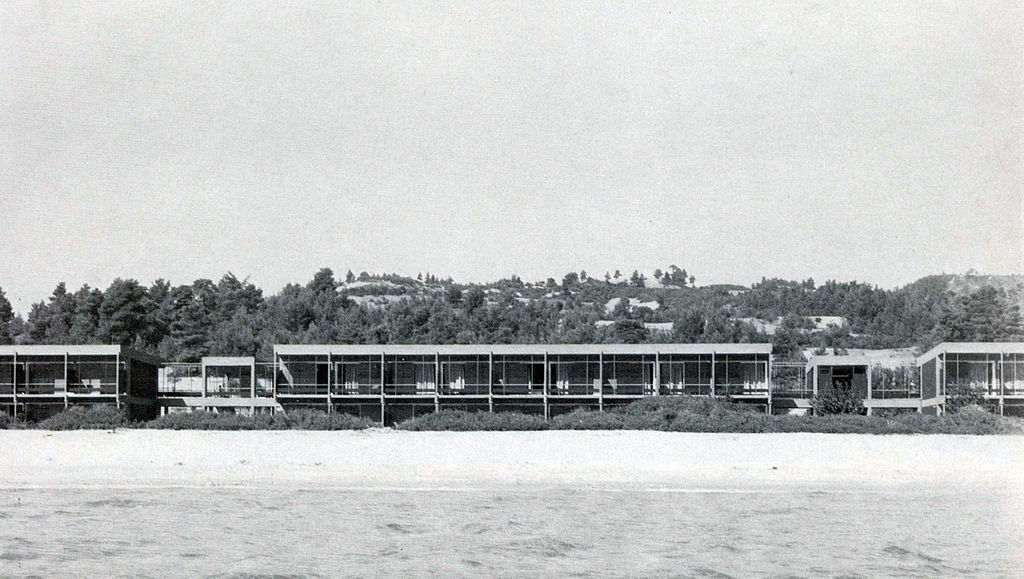
His quote “I believe in dreams, not fantasy” marked the life and work of famed Greek architect Aris Konstantinidis (1913-1993).
Long heralded as the father of Greek architectural modernism, Konstantinidis built many iconic buildings around Greece during his long career, and helped expand Greece’s tourism industry with his many hotels.
Born in Athens in 1913, Konstantinidis left to study architecture in Germany in 1931.
Konstantinidis encounters modernist architecture in Germany
Before the rise of the Nazis in 1936, and their campaign to suppress modernist art and architecture, which they considered “degenerate,” there was a brief cultural renaissance, during which modernist architecture flourished.
At the time, Germany, known then as the Weimar Republic, was a hotbed of scientific research about sex and gender, emerging art and architecture movements, and innovative music styles, all of which the Nazis later used as examples of “degeneracy.”
It was during this period of artistic exploration that Konstantinidis was introduced to German modernist architecture, especially the Bauhaus movement, which rejected embellishment and considered the form of a building of equal importance to its function.
Strong lines and geometric shapes are emblematic qualities of the minimalist European modernist buildings, considered as severe and brutal by some.
Returning to Greece in 1936, Konstantinidis incorporated these qualities of European modernism with local Greek building tradition and history.
Whereas the Nazis saw a rejection of tradition in modernist architecture, preferring a neoclassical style, Konstantinidis saw many parallels between Greece’s ancient past and native architecture and the new, experimental modernist style blooming around Europe.
Removing the embellishment from ancient Greek temples, their strong vertical lines of columns and geometric qualities resembled the aims of modernism.
Similarly, the simple, white-washed homes found in islands all over Greece, both functional and beautiful, seemed to have modernist qualities from long before the movement even began.
Embracing Greece’s native architectural traditions and incorporating elements of the country’s stunning landscape, Konstantinidis crafted a new modernist style, distinct to Greece, which honored the beauty of simplicity.
Greece’s state-run Xenia hotels
In the late 1950s, after working in the planning department of Athens and the Ministry of Public Works, Konstantinidis was hired by the Greek National Tourism Organization for their latest project, the construction of a series of hotels called “Xenia” around the country.
In the middle of the twentieth-century, Greece was only beginning to see a small trickle of international tourism. Hotels at that time were mainly found in large cities and on a few islands.
Hoping to capitalize on the country’s natural beauty and fascinating history, the Greek National Tourism Organization set out to construct kiosks, organized beaches, and other facilities necessary for tourism in areas that were relatively unknown outside of Greece.
Xenia Hotel, Kalambaka (1960) – Aris Konstantinidis#Arquitectura pic.twitter.com/6Xnl9b8qQw
— Manuel Revilla (@ManuelRevilla57) May 7, 2020
Part of this mission was the construction of hotels in the trendy and sophisticated mid-century modernist style at the most beautiful destinations in the country, especially those that had no other hotels to house tourists.
The Xenia project was one of Greece’s largest infrastructure schemes, and its proponents hoped that increased tourism would bring an economic boost to rural areas which had been left behind by industrial development.
Konstantinidis, along with a team of other modernist architects, designed hotels in breathtaking locations such as Mykonos, Andros, Chalkidiki, Kalabaka, and Olympia from 1957 to 1967.
At their time, the publicly-funded hotels were heralded around Europe for their beauty and cutting-edge designs.

In the 1980s, the Greek National Tourism Organization officially ended the Xenia project, and its iconic hotels were sold off to private operators.
After this, many of the architectural masterpieces were either left in ruins, and the ones still in operation were substantially changed during later renovations.
The legacy of Aris Konstantinidis
The Xenia hotel in Paliouri, Chalkidiki, along with the hotel in Andros, are notably in ruins. Both are ugly, decaying shells of what were once shining examples of Greek modernism, hailed around Europe, which accommodated a great many fashionable tourists in the mid-twentieth century.
In addition to hotels, Konstantinidis designed public housing in cities around Greece, such as Athens and Serres. He also designed the plans for the Archaeological Museums of both Ioannina and Komotini.
His private endeavors include the stunning home of Greek painter Yiannis Moralis on the island of Aigina, where the painter spent nearly half the year, creating some of his best known works.
Hotel Xenia
Poros. Attica. Grecia 1961_64
Aris Konstantinidis#juevesDeArquitectura pic.twitter.com/P3KJgI7WcH— jblPaz (@jblpaz) March 5, 2020
Konstantinidis wrote many books and essays about architecture, art, and literature and was given an honorary doctorate from the University of Thessaloniki for his contributions to Greek architecture.
He also taught as a visiting professor at the Zurich Polytechnic and was a member of the Academy of Fine Arts, Munich.
Konstantindis married renowned Greek sculptor Natalia Mela, the granddaughter of famed General Pavlos Melas, and the couple had two children. He died at the age of eighty in Athens in 1993.
See all the latest news from Greece and the world at Greekreporter.com. Contact our newsroom to report an update or send your story, photos and videos. Follow GR on Google News and subscribe here to our daily email!



